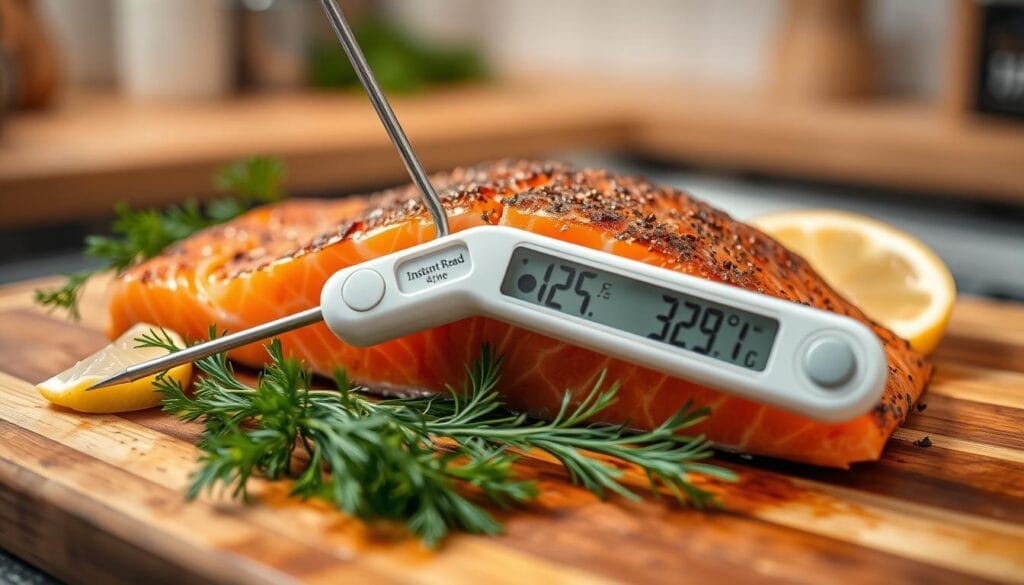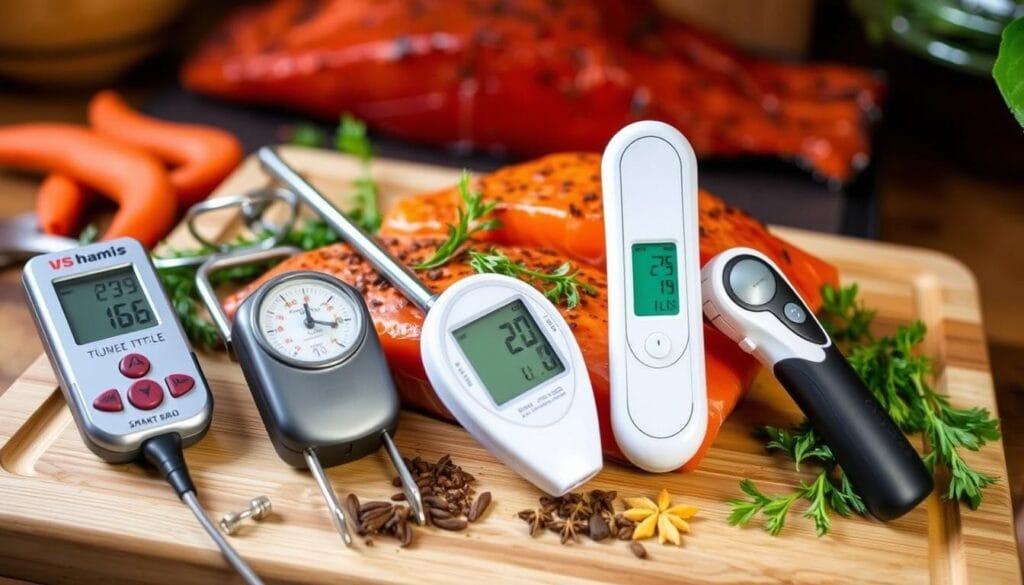The smell of smoked salmon internal temp in my kitchen reminds me of summer days with my grandfather. He learned how to smoke fish during his travels by the sea. As someone who loves to cook, I found that making smoked salmon is both an art and a science.
Smoking salmon is more than just cooking. It’s about making a dish that’s safe, flavorful, and rooted in tradition. Knowing the right internal temperature is key to whether old methods inspire you or want to add Jamaican flavors.
This guide will teach you how to get the perfect internal temperature for smoked salmon. We’ll explore global cooking traditions, like Jamaican beef patties while making sure your dish is tasty and safe to eat.
Key Takeaways
- Precise temperature control is essential for safe and delicious smoked salmon
- Internal temperature impacts both food safety and flavor development
- Different smoking techniques require specific temperature ranges
- Proper equipment and technique are critical for successful salmon smoking
- Understanding temperature helps prevent overcooking and moisture loss
Understanding the Importance of Proper Salmon Temperature
Smoking salmon is like making a fine caribbean food or meat pie. Getting the temperature right is key. It ensures your salmon is not only safe but also a gourmet treat.

Food Safety Standards for Fish
Temperature is your best defense against foodborne illnesses when cooking seafood. For salmon, the right internal temperature is vital to kill harmful bacteria. Both professional chefs and home cooks must follow strict guidelines for safe eating.
- Minimum safe internal temperature: 145°F
- Cooking time varies based on salmon thickness
- Use a reliable meat thermometer for accuracy
The Role of Temperature in Flavor Development
Temperature is not just about safety; it also affects flavor. Slow, controlled smoking lets salmon soak up smoky flavors while keeping its texture soft. This is similar to how chefs in caribbean food and pastry control heat to boost taste.
“Precision in temperature is the secret ingredient to extraordinary smoked salmon.” – Culinary Expert
Texture and Moisture Retention Basics
| Temperature Range | Texture Result | Moisture Level |
|---|---|---|
| 120-130°F | Soft, tender | High moisture retention |
| 140-150°F | Firmer texture | Moderate moisture |
| 160°F+ | Dry, tough | Low moisture |
Knowing these temperature details helps you make smoked salmon that’s safe and delicious. Whether you’re a pro chef or a home cook, mastering temperature is the key to culinary success.
Essential Equipment for Monitoring Smoked Salmon Internal Temp
Achieving perfect smoked salmon needs precision. The right tools make a big difference. Whether you’re making island flavors or spicy patties, knowing the temperature is key for safety and taste.

Choosing the right thermometer can change your smoking game. Digital instant-read thermometers give the most accurate salmon temperatures. Look for ones with:
- Quick response times
- Waterproof capabilities
- Wide temperature range
- Precise calibration
Professional chefs say a high-quality digital probe thermometer is worth it. These tools let you check internal temperatures without opening your smoker. This keeps the heat steady and saves those island flavors.
“Temperature control is the secret to perfect smoked salmon” – Professional Smoking Expert
For those who love spicy patties and seafood, here are more tools to consider:
- Wireless Bluetooth thermometers
- Infrared surface temperature guns
- Multiple-probe smoker thermometers
Remember, tracking temperatures accurately keeps food safe and makes it taste great every time you smoke salmon.
Preparing Your Salmon for Smoking
Smoking salmon is all about getting the flavor and texture just right. It starts with picking the best ingredients and techniques. These steps turn a simple fish into a dish that’s truly special.
Selecting the Right Cut of Salmon
Great smoked salmon begins with top-notch fish. Look for salmon that’s fresh, firm, and has a bright color. It should also have a mild smell. Wild-caught salmon usually tastes better than farm-raised.
- Choose center-cut salmon for the most consistent smoking
- Opt for skin-on fillets to help retain moisture
- Remove any pin bones for a smooth texture
Brining and Seasoning Techniques
Brining makes your salmon juicy and flavorful. A wet brine mix of salt, sugar, and water is a good start. You can then add turmeric seasoning for extra taste.
“The secret to exceptional smoked salmon lies in the brine and seasoning.”
Adding turmeric seasoning gives your salmon a golden color and a warm, earthy taste. Mix it with black pepper, garlic powder, and brown sugar. This blend enhances the salmon’s natural flavor.
Setting Up Your Smoker
Getting your smoker ready is key for that flaky texture. Use wood chips like alder and apple that match salmon’s light flavor.
- Preheat smoker to recommended temperature
- Ensure proper ventilation
- Place salmon skin-side down on clean grates
- Monitor temperature consistently
Follow these steps to make smoked salmon that will wow everyone.
The Perfect Temperature Range for Smoking Salmon
Getting the right temperature when smoking salmon is key to making a dish that’s as tasty as Jamaican beef patties. You need to control the heat well to turn simple fish into a masterpiece.
The best temperature for smoking salmon is between 175°F and 225°F. This range helps bring out rich flavors and keeps the fish tender. It’s like making a perfect golden crust – you need to be precise.
- Low and Slow: 175°F is ideal for a gentle smoking process
- Medium Heat: 200°F provides balanced flavor development
- Higher Temperature: 225°F works for quicker smoking sessions
“Temperature control is the secret to transforming ordinary fish into an extraordinary culinary experience.” – Professional Smoker
Different salmon cuts might need slight temperature changes. Fatty fish like sockeye might do better at lower temperatures than leaner fish. Your aim is to make smoked salmon that’s moist, flavorful, and safe.
Just like Jamaican beef patties need careful heat to get that golden crust, salmon does too. Keep an eye on your smoker’s temperature and adjust as needed.
How to Check Smoked Salmon Internal Temp Correctly
Mastering temperature control is key when making smoked salmon. Whether you’re into traditional caribbean food or trying out jamaican cuisine, getting the internal temperature right is important. It ensures both safety and great flavor.
Accurate temperature measurement needs careful technique and the right tools. Knowing how to check your smoked salmon’s internal temperature can improve your cooking skills. This is true for many culinary traditions.
Proper Thermometer Placement
Here are some important guidelines for checking the salmon’s temperature:
- Insert the thermometer into the thickest part of the fish
- Avoid touching bones or skin
- Make sure the probe reaches the center of the fillet
Reading Temperature Accurately
Different cooking methods in jamaican cuisine need specific temperature ranges. For smoked salmon, aim for an internal temperature between 145°F and 150°F. This ensures food safety.
| Cooking Method | Target Temperature |
|---|---|
| Smoking | 145-150°F |
| Grilling | 145°F |
| Baking | 145°F |
Common Temperature Testing Mistakes
Avoid these common errors when measuring smoked salmon temperature in caribbean food preparation:
- Using an uncalibrated thermometer
- Not cleaning the probe between uses
- Rushing the temperature check
- Relying solely on visual cues
“Precision is the secret ingredient in transforming good cooking into great cuisine.” – Professional Chef
Remember, consistent practice will help you develop an intuitive sense for perfectly cooked smoked salmon across diverse culinary traditions.
Smoking Time and Temperature Chart
Smoking salmon is all about precision. It’s like making a gourmet pastry. Knowing the right temperature and timing is key to making your salmon taste amazing.
Success in smoking salmon depends on a few important things. Different cuts of salmon need specific temperatures and smoking times. This ensures they taste and feel their best.
| Salmon Cut | Recommended Temperature | Smoking Time |
|---|---|---|
| Sockeye Salmon Fillet | 165°F | 2-3 hours |
| King Salmon Steak | 170°F | 3-4 hours |
| Coho Salmon Portions | 160°F | 1.5-2 hours |
Smoking salmon is like making a perfect pastry or meat pie. You need to pay close attention to detail. The temperature chart guides you through the process.
- Always use a reliable meat thermometer
- Check internal temperature at the thickest part
- Allow for resting time after smoking
“Precision in temperature is the secret to transforming simple ingredients into extraordinary dishes.”
By following these tips, you’ll make smoked salmon that’s as good as a restaurant’s. It will bring top-notch flavor to your kitchen.
Bake a quick mug cookie or try a microwave cookie dessert.
Troubleshooting Temperature Issues While Smoking
Smoking salmon needs precision and careful attention to temperature. Weather and equipment can cause unexpected challenges. Knowing how to handle these ensures your smoked fish and spicy patties stay top-notch.
Managing Temperature Fluctuations
Temperature changes can greatly affect your smoking results. Experts suggest several ways to keep the heat steady:
- Use a high-quality digital thermometer
- Position smoker in sheltered areas
- Minimize lid openings during smoking
- Implement wind barriers around your smoker
Weather Condition Adjustments
Different weather calls for different smoking strategies. Cold or windy weather needs extra care to keep those rich island flavors in your spicy patties and salmon.
| Weather Condition | Recommended Action |
|---|---|
| Cold Temperatures | Increase heat source intensity by 10-15% |
| Windy Conditions | Create wind protection around smoker |
| High Humidity | Use additional ventilation |
“Mastering temperature control transforms good smoking into exceptional culinary art.” – Smoking Experts
By using these methods, you’ll always get perfectly smoked dishes. They’ll show off authentic island flavors and keep the right temperature during smoking.
Storage and Food Safety After Smoking
After making your smoked salmon with turmeric seasoning, keeping it fresh is key. Knowing how to store it right will let you enjoy it for days.
Keeping your smoked salmon in the fridge is essential. Here are some important storage tips:
- Cool the smoked salmon completely before storing
- Wrap tightly in plastic wrap or vacuum-seal
- Store in the coldest part of your refrigerator
- Consume within 3-4 days for optimal flavor
Keeping the right temperature is vital to stop bacteria from growing. Your fridge should stay below 40°F (4°C). Use a thermometer to check this important food safety detail.
| Storage Method | Recommended Duration | Best Practices |
|---|---|---|
| Refrigerated (Wrapped) | 3-4 days | Airtight container, below 40°F |
| Frozen | 2-3 months | Vacuum-sealed packaging |
“Fresh is best, but proper storage can extend the life of your smoked salmon without compromising taste or safety.” – Professional Chef’s Recommendation
When you reheat, make sure it gets to 165°F. This kills any bacteria. Your homemade smoked salmon with turmeric seasoning needs careful handling to keep its great taste and texture.
Pro tip: Always trust your senses. If the salmon smells bad, looks off, or feels slimy, throw it away. This prevents food poisoning.
Conclusion
Getting the perfect smoked salmon internal temp is like an art. It turns simple fish into a fancy dish. You’ve learned how to check temperature, pick the best salmon, and make a golden crust.
Success in smoking salmon needs precision and patience. Knowing how temperature, smoking time, and safety work together is key. This way, you can make smoked salmon as good as restaurants in your kitchen.
Remember, practice is key for smoked salmon. Every time you smoke, you can get better. You can try new things and make your own special golden crust. With what you’ve learned, you can wow your friends and family with amazing smoked salmon.
Start your culinary adventure and keep trying new things. Paying attention to temperature and smoking methods will make your smoked salmon delicious, safe, and beautiful every time.
FAQs
What is the ideal internal temperature for smoked salmon?
Smoked salmon should be cooked to 135°F to 140°F (57°C to 60°C). This ensures it’s safe to eat and tastes great. It’s like cooking Jamaican beef patties to keep their flavor and texture just right.
How do I accurately measure the internal temperature of smoked salmon?
Use a meat thermometer in the thickest part of the salmon. Make sure the probe doesn’t hit bones or the rack. This is as important as in Caribbean cooking.
Can I use the same smoking techniques for other meats and pastries?
Yes! Temperature control is key for many island dishes. Just as with smoked salmon, it works for meat pies and spicy patties too.
What seasonings work best with smoked salmon?
Turmeric adds a special flavor to smoked salmon. Dill, black pepper, and sea salt are also great. These seasonings are like those in Jamaican dishes, adding bold flavors.
How long should I smoke salmon to achieve the perfect golden crust?
Smoking time depends on salmon thickness, usually 2 to 4 hours at 225°F (107°C). Aim for a golden crust, like Jamaican beef patties.
What are the food safety considerations when smoking salmon?
Salmon must reach 145°F (63°C) to be safe. Use a meat thermometer and keep things clean, just like in Caribbean cooking.
How should I store smoked salmon after cooking?
Store smoked salmon in the fridge within two hours, in an airtight container. It lasts 3-4 days. This is similar to keeping other seafood and pastry fresh.
Can I smoke salmon in different weather conditions?
Yes, but adjust the temperature. Cold or windy weather might need more heat to keep the temperature steady. This is like how island dishes are cooked in various conditions.


2 thoughts on “Smoked Salmon Internal Temp”